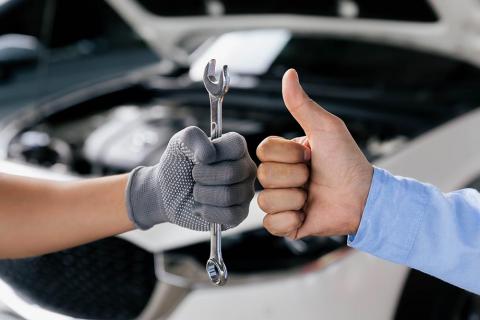As the summer comes to an end and the back-to-school season kicks into high gear, it's not just the kids who need to be prepared—your car does too. Just like your students need to be ready for the challenges of a new school year, your vehicle needs some attention to ensure it's up to the task of getting everyone where they need to go safely and reliably. Here are some back-to-school-themed car maintenance tips to help you get your vehicle in A+ condition.
1. Tire Check: The Foundation of a Good Start
Just like sturdy shoes are essential for walking to class, your car needs reliable tires to get you safely to school, work, and beyond.
- Tread Depth: Think of tread depth like the grip on new sneakers. Without it, you'll slip and slide, especially in wet conditions. Use the penny test to make sure your tires have enough tread.
- Tire Pressure: Properly inflated tires are like a good pair of running shoes—they provide the support your car needs for smooth, efficient travel. Check the pressure regularly, as it can fluctuate with the seasons.
- Rotation and Alignment: Just as kids need regular study sessions to stay sharp, your tires need regular rotation and alignment to ensure even wear and tear.
2. Brake Inspection: Stop, Collaborate, and Listen
Brakes are like your child's favorite teacher—reliable, dependable, and there when you need them most.
- Brake Pads and Rotors: If your brakes are making noise, it's like your kid complaining about a heavy backpack—it’s time to lighten the load. Worn brake pads or rotors need to be replaced to ensure your car stops safely.
- Brake Fluid: Just as hydration is crucial for kids during gym class, brake fluid is essential for your car. Check the level, and if it’s looking dark, a brake fluid flush might be in order.
3. Battery Check: Stay Charged for the School Year
Just like your kids' social battery can run down after a long day, your car battery can wear out too.
- Battery Terminals: Think of the terminals like your child’s locker—keep it clean to prevent issues. Corrosion can affect the battery's performance, so clean the terminals if needed.
- Battery Life: Just as a good night's sleep is essential for your child, a healthy battery is crucial for your car. If it’s been 3-5 years since you last replaced it, consider a check-up or replacement to avoid unexpected breakdowns.
4. Fluid Levels: Keeping Your Car Hydrated
Just like a student needs to stay hydrated for peak performance, your car needs its fluids topped off.
- Engine Oil: Think of engine oil like brain fuel—without it, everything slows down. Check the oil level and quality, and change it if it’s time.
- Coolant: Coolant is like a refreshing drink on a hot day. It keeps your engine from overheating, so make sure it’s at the right level.
- Transmission Fluid: If your transmission fluid is low, it’s like trying to read without glasses—it just doesn’t work right. Keep it filled and clean for smooth shifting.
- Windshield Washer Fluid: Clear vision is essential, just like good study habits. Top off the washer fluid to keep your windshield clean, especially in unpredictable fall weather.
5. Light Check: Brighten Your Way to School
Proper lighting is like a good set of highlighters—it helps you see what’s important.
- Headlights: Your headlights are like the first light in the morning—essential for clear visibility. Make sure both high and low beams are working properly.
- Brake Lights: Think of brake lights as the red pens that correct mistakes. If they’re out, it’s a problem waiting to happen.
- Interior Lights: Interior lights are like a night light—making sure you can see clearly in the dark. Check that all dashboard indicators and interior lights are functioning correctly.
6. HVAC System: Comfort in All Seasons
Just like a cozy sweater on a chilly day, your car's heating, ventilation, and air conditioning (HVAC) system should keep you comfortable no matter the weather.
- AC Performance: Think of the air conditioning as your kid's favorite ice cream treat—refreshing and essential in hot weather. Make sure it’s cooling effectively.
- Heater Function: As the temperature drops, you’ll need your heater to be as reliable as a warm classroom on a cold day. Test it to ensure it’s working properly.
- Defroster: The defroster is like wiping fog off your glasses—it’s crucial for clear visibility. Make sure it’s ready to go for those frosty mornings.
7. Wiper Blades: Clear the Way Ahead
Just like clear notes make for better studying, clear visibility is key to safe driving.
- Blade Condition: Your wiper blades are like a new set of markers—if they’re streaking or smudging, it’s time for a replacement.
- Consider Upgrades: If you live in an area with heavy rainfall, think of upgrading to high-performance blades, just like upgrading from pencils to pens.
8. Visual Inspection: The Final Check Before Class
A quick walk around your car is like a final review before a big test—make sure everything’s in order.
- Leaks: Look under the car for any signs of leaks, just like you’d check a backpack for forgotten homework. If you spot anything, get it checked out.
- Body and Paint: Inspect for any dents or scratches, just like checking your clothes for stains before school. Address any issues before they get worse.
- Belts and Hoses: Under the hood, belts and hoses should be in good shape, like making sure your shoelaces aren’t frayed.
9. Schedule a Professional Inspection: Get the Teacher’s Approval
If you’re unsure about any of these checks, think of a professional inspection like getting a tutor—sometimes, it’s best to call in the experts. Stop by today or give us a call, and we can do an inspection and catch issues before they become major problems, giving you peace of mind.
10. Prepare an Emergency Kit: Pack Your School Supplies
Just like a well-packed backpack ensures a smooth day, an emergency kit in your car can keep you prepared for any situation.
- Jumper cables: For those unexpected moments when your battery needs a boost.
- Tire pressure gauge: Keep an eye on your tire health.
- First-aid kit: For minor injuries or emergencies.
- Flashlight: Because you never know when you’ll need some extra light.
- Basic tools: A small tool kit can be a lifesaver.
- Blanket and warm clothes: Just like an extra sweater in your locker, these can keep you warm in case of an emergency.
- Non-perishable snacks and water: Stay fueled and hydrated, just like a good lunch keeps your student going.
Final Thoughts
The back-to-school season is busy, but taking the time to maintain your car can save you from unexpected breakdowns and costly repairs. By following these tips, you’ll ensure your vehicle is safe, reliable, and ready for the challenges of the new school year. Safe driving, and have a great school year!


 Mon-Fri: 8am-5pm | Closed daily for lunch: 11:30am-12:30pm
Mon-Fri: 8am-5pm | Closed daily for lunch: 11:30am-12:30pm (402) 339-6460
(402) 339-6460 219 E 1st St, Papillion, NE 68046
219 E 1st St, Papillion, NE 68046






